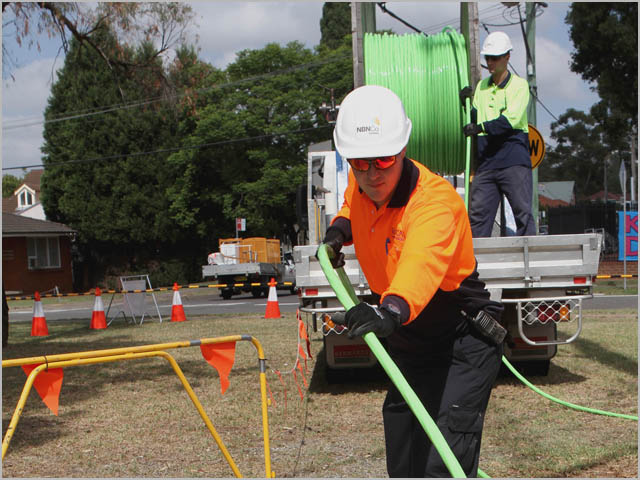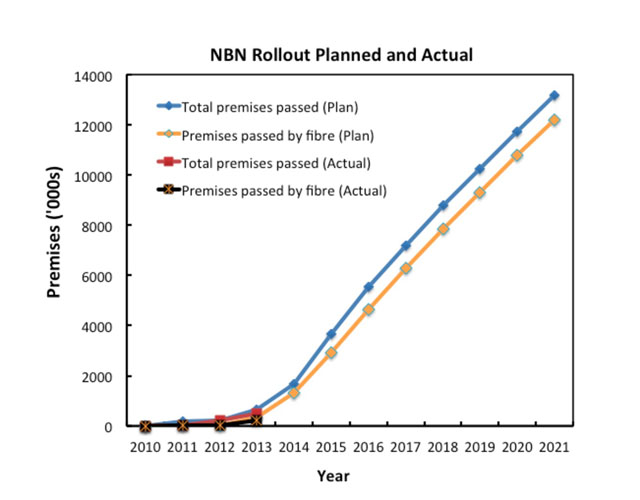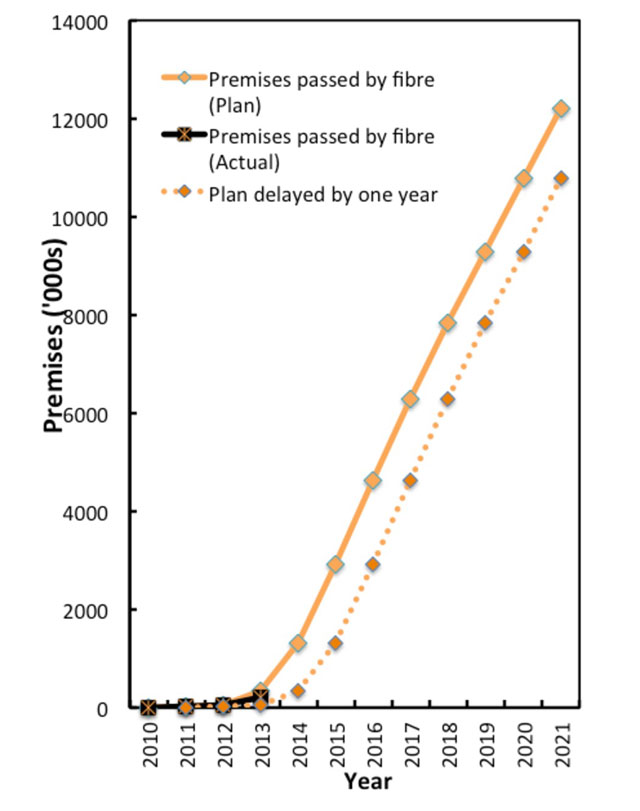This article is by Rod Tucker, director of the Institute for a Broadband-Enabled Society at the University of Melbourne. It was reviewed by Philip Branch, senior lecturer in Telecommunications at the Swinburne University of Technology. It originally appeared on The Conversation.
“At the current rate of roll-out, the National Broadband Network (NBN) won’t cover the whole country for 20 years.” – Opposition Leader Tony Abbott, National Press Club, 11 August.
analysis The above claim on the NBN has been made many times by the Opposition, including by shadow communications minister Malcolm Turnbull.
The government admits the roll-out has slowed but insists the project will be completed on schedule by 2021. The delays, it argues, are partly due to the longer-than-expected negotiations with Telstra to get access to Telstra’s infrastructure, and partly due to problems caused by the discovery of asbestos in some Telstra ducts and pits.
When contacted by Election FactCheck, Turnbull’s office disputed the government’s reasons, arguing that the interim agreements with Telstra were reached at an early stage and construction could have started sooner. Turnbull’s spokesman said a faster roll-out had been hampered by other problems, such as difficulties with workforce mobilisation.
“Despite its chronic inability to meet any construction ramps to date, the NBN continues to make the construction ramp-up steeper, with no indication how it will meet the additional construction capacity needed,” Turnbull’s spokesman said.
(You can read the full response from Turnbull’s office here.)
But let’s look at the data to see if a 20 year rollout is likely. The graph below shows NBNCo’s projected or planned total number of premises passed by fibre, wireless and satellite (blue line) and the planned number of premises passed by fibre only (orange line) from 2010 until the scheduled completion date of the NBN in 2021. (When a premises is passed, an NBN service is available, but the service is not necessarily connected). Note that some of the planned numbers have been revised by NBNCo last year, since the Company’s original planning document was released in 2010.
The graph also shows the actual total number of premises passed (red line) and actual number of premises passed by fibre (black line).
It is clear from the graph that NBNCo’s roll-out plan allows for a relatively slow ramp up from 2010 to 2013, with an acceleration of the roll-out in 2014, 2015, and 2016, as more skilled workers come online. Because the roll-out is still in its early stages, it is difficult to see, on the scale of this graph, the difference between the planned and actual numbers.
But we know that the actual number of premises passed by satellite in 2013 is ahead of the original schedule, and the actual number of premises passed by fibre in 2013 (207,500) lies between the planned figure for 2012 (39,000) and the planned figure for 2013 (341,000). Based on the available data, the roll-out is ramping up, but it is about six to nine months behind schedule.
We don’t have the specific calculations underlying the 20 year roll-out figure and it is hard to imagine where this number comes from. Abbott’s statement is qualified by “at the current rate of roll-out”. But the current rate of roll-out is irrelevant because NBNCo has, in fact, been able to ramp out the rate of roll-out as the supply chain for labour, materials and equipment matures and expands. There is reason to believe that the rate of roll-out will further increase in coming years.
If we take into account the fact that NBNCo is indeed ramping up its roll-out rate, and accept the government’s assurances that the reasons for the delays to date are now taken care of (which the Opposition does not accept), then it may be reasonable to expect that the orange line on the graph above will have the same shape as shown in the figure below (but be moved about six to twelve months to the right).
To illustrate this, the graph below shows the planned number of premises passed by fibre (orange line) and a copy of this line, moved twelve months to the right (orange dotted line). In this graph we have stretched the vertical axis to give a clearer view of the actual number of premises passed by fibre (black line).
This graph shows that the actual number of premises passed by fibre in 2013 exceeds the number predicted by the dotted orange line in 2013. But the dotted orange line reaches the full 12 million premises passed in 2022 rather than 2021. Under this scenario, the time to completion would be around nine years from now.
What is clear from this discussion is that in a project lasting more than 10 years, early-stage delays do not necessarily imply a major deviation from the longer-term plan. Any attempt to project the initial activity in a major project like the NBN into the future is a fraught process.
Verdict
Predicting the future on big infrastructure projects is inherently complex. Deviations from the plan in the early stages of large projects do not automatically overturn the original timeframe. The 20-year time to completion quoted by Tony Abbott seems to be some kind of rough estimate or guess, based on unclear assumptions. It is unlikely to be correct.
Review
The analysis in this article appears quite sound.
If you take the claim literally, on the current rate completion, it will not take 20 years as Abbott says: it will take much longer. However, as the author also points out, projects like this involve an increase in the rate of roll-out; that is, an acceleration in deployment. Modelling the time taken to completion requires assumptions to be made as to the size and timing of this acceleration.
If no further problems emerge similar to the discovery of asbestos in Telstra ducts and NBNCo’s planned acceleration in deployment is achieved, then the nine years suggested in the article is a more plausible estimate than 20 years. Of course, these are substantial assumptions, but the article shows they are not unreasonable.
The key point is in the last paragraph, which says that “Any attempt to project the initial activity in a major project like the NBN into the future is a fraught process.” Without providing specific information as to his underlying assumptions, Abbott’s claim of 20 years has to be regarded as questionable. – Philip Branch
The Conversation is fact checking political statements in the lead-up to this year’s federal election. Statements are checked by an academic with expertise in the area. A second academic expert reviews an anonymous copy of the article. Request a check at checkit@theconversation.edu.au. Please include the statement you would like us to check, the date it was made, and a link if possible.
Rod Tucker was a member of the National Broadband Network Panel of Experts, appointed by the Rudd government in 2008 to assess proposals for and provide advice on the NBN. You can read more about that panel here. Philip Branch does not work for, consult to, own shares in or receive funding from any company or organisation that would benefit from this article, and has no relevant affiliations.
This article was originally published at The Conversation. Read the original article. Image credit: NBN Co.
![]()




Delimiter needs to be fact checked as to whether what it is doing in this story is fact checking, ie, checking facts. There are no facts in the story except what the projected rollout rate was, and how far short of it currently is. What it will succeed in doing in the future is outside the domain of what is facts.
The question that is being discussed is whether NBNCo will, as more time passes, stay as far behind it is now in percentage terms (207,000/341,000=40% behind) and take two thirds longer (12 + 8 = 20) than planned to complete, or whether all its problems are over and it will stay as far behind in numbers (341,000-207,000=134,000) and only take a matter of months more than planned to complete. Who knows?
1) Your mathematics is faulty. You aren’t, I take it, an engineer.
2) This is The Conversation’s FactCheck (republished with permission), not Delimiter’s. That’s at the top of the page.
+1…
d’oh…!
No, to be fair to Gordon, for once he has a fair point. Putting the exact maths aside, the claim by The Turnbull is that the percentage delay will follow through the entire project, while the claim by NBN Co is that the delay is a timeshift that shouldnt get noticably worse.
So it is a question of whether the project would take a further 8 years or 8 months. Those are as good a number as any to use, its not beneficial to quibble over whether its 6 years, 8 years, or 12 years, any of them is significant and, if true, a fair argument against FttH.
I expect the reality to be in the middle, well and truly closer to 8 months than 8 years. There is direct evidence that Telstra caused delays, as did initial skilling, and that when you account for those delays there hasnt been much more getting in the way. And the plan always accounted for a slow start.
To me, if the delay is going to be in the range of years, we’re not going to know for certain until 2016 or so when its well and truly under way. This rampup stage is no indicator one way or another, and because of the rampup of rollout to come (6000/day?), the relatively small shortfall of ~100,000 needs to be made up at the rate of about 35 a day.
Hardly the end of the world.
http://www.theaustralian.com.au/business/in-depth/thousands-of-faults-hit-rushed-nbn/story-e6frgaif-1226712731555
This doesn’t help the pro FTTH brigade either!
Ah yes “The Australian”…
Should really be called “The American” considering it’s owner is no longer an Australian citizen…
Ah the expert Private sector contractors that the Coalition is so busy touting are at it again
I just assumed that article was magically telewarped from the future somehow :-)
Perhaps via “lasers”?
Having already delayed the NBN enabling legislation 9 months with filibusters, Malcolm Turnbull says he will now halt the rollout and design and cost a new (vintage 2005) project to build 70,000 nodes and replace bad copper to premises.
If Turnbull’s post-election delay pushes his copper broadband delivery timeframe out to 2022 instead of 2019, postponing for a further decade the commencement of the urban fibre build, he can rest assured his name will forever be associated with two Australian internet milestones, or was that millstones.
The best way to find out how long it will take is to determine how long it will take to reach the maximum roll out-speed. Not if they reached their short term targets. If they are 40% behind it could mean anything.
In overseas countries like Singapore their rollout speed is 3000 premises serviceable a week. IE 3000 new premises can actually connect to fibre a week. If this rollout speed was applied here it would take 67 years at FULL SPEED rollout to connect 10.5M premises. If the new premises built in this time this would increase the roll-out rate by 20% = 80 Years.
Now for the NBN to be completed on time by 2021. They would need to be able to connect (10.5M + 5% premises)
That means to complete the NBN in the next 416 weeks (8 years) and connect the remaining (10.5M * 1.05) – 120,000 (homes that can order a service)
They need to pass 26,213 premises per week. OR 113K a month. At a rate roughly 8-10X the speed of other countries rolling out their FTTP. In fact the required speed is likely to be around 3X the combined world rollout speed of fibre. Ie if we hired all the firms in the world currently deploying FTTP and set them to work on the NBN we would hit only 30% of the required rollout speed.
I take it that you havent looked at the numerous studies showing that 6,000 premises a day is definitely possible, have you? 5 day working week, there’s 30,000 a week. Work 7 days, there’s 42,000 a week. But if you work on your 26,000 a week figure over a 7 day week, then its not even 4,000 a day.
FYI, 26,000 a week isnt accurate anyway. Not really. While the rollout is still ramping up, you’re never going to hit that mark, so the number is going to increase upwards week on week and end up getting closer to the 30,000 a week mark they are aiming for,
Work with the understanding that 6,000 a day is doable. And because thats based on a 5 day working week, there is a 30% redundancy built in as a catch up – Saturday and Sunday. How do delays add up if they start rolling out on the weekend as well? At the moment, they only need to catch up around 35 houses a day to get back on track for a 2021 finish, so having the ability to add on 6,000 or 12,000 a day is an incredible luxury.
The issue isnt whether they can do 6,000 a day, its how fast they can train enough people to be able to do it. And again, because of the luxury of having weekends spare, it can take a little longer to train them, and still leave space to catch up.
And yes, that may come at a cost. If they are 200,000 properties behind and it takes 2 months of working Saturdays to catch up, its worth it. Or it may be something the contractors have to absorb, given they have commited to X number per day on average.
Are you aware of the rollout speed achieved by Telstra AND Optus rolling out their Cable
“Professor Rod Tucker and Professor Reg Coutts were part of the six-person expert panel that advised Communications Minister Stephen Conroy to reject the four national bids for the tender and instead take a majority share in a new $43 billion network.”
http://www.theage.com.au/business/telstra-will-be-involved-with-nbn-20090518-bcum.html
Perhaps Rod Tucker dismisses claims in order to protect his reputation?
In any case 20 years is just a simple rule-of-thumb projection base on current trends.
Another estimate has been made by the Coalition which includes the “ramp up” that Tucker mentions.
In their background paper, the Coalition say that the NBN will be finished in 2025:
“The remaining NBN rollout, scheduled to take 8 years, actually takes 12 years. This results in higher capex due to replacement of short‐lived network elements and more premises to serve, and a much lower ramp in revenues than the best‐case scenario in the Corporate Plan.”
http://www.malcolmturnbull.com.au/assets/Coalition_NBN_policy_-_Background_Paper.pdf
(pg 28)
This sounds plausible in light of revelations from the AFR:
“NBN to miss 2014 target for rollout”
http://www.afr.com/p/technology/nbn_to_miss_target_for_rollout_XInJGPQsAGEsJxgEcAKrbP
Even NBN supporter Dr Mark Gregory of RMIT believes the NBN will take ten more years to complete:
http://www.abc.net.au/news/2013-03-22/nbn-rollout-could-be-delayed-by-10-years3a-expert/4589520
Interestingly, if the NBN is four years late then that satisfies one of the Coalition’s assumptions that Labor’s NBN will cost $94 billion – twice that which Labor has said it will cost and three times that which the Coalition plan is said to cost.
On what basis could it take double the time?
Are you expecting them to halve their workforce or something?
““The remaining NBN rollout, scheduled to take 8 years, actually takes 12 years. This results in higher capex due to replacement of short‐lived network elements and more premises to serve, and a much lower ramp in revenues than the best‐case scenario in the Corporate Plan.””
I like that statement – let’s go through it one by one:
“This results in higher capex due to replacement of short‐lived network elements”
Like which ones exactly? And these parts that are getting replaced… have paying customers on yes?
“and more premises to serve”
So… more customers? Meaning more revenue? This is bad?
“and a much lower ramp in revenues than the best‐case scenario in the Corporate Plan”
Including a lower ramp up in costs? With a higher total revenue target by your own arguments?
—-
It’s not exactly the most persuasive argument ever written.
Regardless of politics outside tech…looks like the headline in relation to the actual NBN will soon be a moot point.
According to today’s polls TA is looking at a 40 seat majority and as such the vision for Australia and Australian’s to be leaders in technology via the NBN will die and we will be destined for mediocrity…
What a shame for us all
Comments are closed.